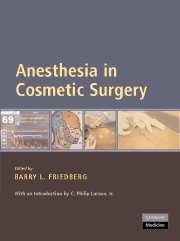Book contents
- Frontmatter
- Contents
- Foreword
- Acknowledgments
- Introduction
- Preface
- List of Contributors
- PART I MINIMALLY INVASIVE ANESTHESIA (MIA)Ⓡ FOR MINIMALLY INVASIVE SURGERY
- 1 Propofol Ketamine with Bispectral Index (BIS) Monitoring
- 2 Preoperative Instructions and Intraoperative Environment
- 3 Level-of-Consciousness Monitoring
- 4 The Dissociative Effect and Preemptive Analgesia
- 5 Special Needs of Cosmetic Dental Patients
- 6 Propofol Ketamine in the UK, Propofol Ketamine Beyond Cosmetic Surgery
- 7 Propofol Ketamine Beyond Cosmetic Surgery: Implications for Military Medicine and Mass-Casualty Anesthesia
- 8 Lidocaine Use and Toxicity in Cosmetic Surgery
- 9 Local Anesthetic Blocks in Head and Neck Surgery
- 10 Local Anesthetics and Surgical Considerations for Body Contouring
- PART II ALTERNATIVE ANESTHESIA APPROACHES IN COSMETIC SURGERY
- PART III OTHER CONSIDERATIONS FOR ANESTHESIA IN COSMETIC SURGERY
- APPENDIX A A Guide to Perioperative Nutrition
- APPENDIX B Reflections on Thirty Years as an Expert Witness
- Index
- References
6 - Propofol Ketamine in the UK, Propofol Ketamine Beyond Cosmetic Surgery
from PART I - MINIMALLY INVASIVE ANESTHESIA (MIA)Ⓡ FOR MINIMALLY INVASIVE SURGERY
Published online by Cambridge University Press: 22 August 2009
- Frontmatter
- Contents
- Foreword
- Acknowledgments
- Introduction
- Preface
- List of Contributors
- PART I MINIMALLY INVASIVE ANESTHESIA (MIA)Ⓡ FOR MINIMALLY INVASIVE SURGERY
- 1 Propofol Ketamine with Bispectral Index (BIS) Monitoring
- 2 Preoperative Instructions and Intraoperative Environment
- 3 Level-of-Consciousness Monitoring
- 4 The Dissociative Effect and Preemptive Analgesia
- 5 Special Needs of Cosmetic Dental Patients
- 6 Propofol Ketamine in the UK, Propofol Ketamine Beyond Cosmetic Surgery
- 7 Propofol Ketamine Beyond Cosmetic Surgery: Implications for Military Medicine and Mass-Casualty Anesthesia
- 8 Lidocaine Use and Toxicity in Cosmetic Surgery
- 9 Local Anesthetic Blocks in Head and Neck Surgery
- 10 Local Anesthetics and Surgical Considerations for Body Contouring
- PART II ALTERNATIVE ANESTHESIA APPROACHES IN COSMETIC SURGERY
- PART III OTHER CONSIDERATIONS FOR ANESTHESIA IN COSMETIC SURGERY
- APPENDIX A A Guide to Perioperative Nutrition
- APPENDIX B Reflections on Thirty Years as an Expert Witness
- Index
- References
Summary
INTRODUCTION
“Nothing can be said to be certain except death and taxes.” Had Benjamin Franklin lived two centuries later, he might have cared to add a third—anesthesia with nausea. It is almost an expectation by both patients with health professionals alike that nausea and vomiting follow general anesthesia: it is the “big little problem,” it “goes with the territory.” Can anesthesiologists honestly conceive of a day when the emesis basin in the PACU is relegated to the museum? Perhaps not, but how far are anesthesiologists moving toward that halcyon day, and exactly just how serious are anesthesiologists about preventing or even treating postoperative nausea and vomiting (PONV)? Just how close are anesthesiologists to “zero tolerance” using what is currently available? Just how often is the full panoply of the available antiemetics prescribed, and just how often are those that are prescribed administered in a timely fashion and by an appropriate route? Just exactly how seriously are anesthesiologists interested in eliminating PONV?
The risk of PONV is generally conceived as an attribute of the patient with subsidiary risks attached to the context, that is, the drugs and operation. However, drugs themselves have no executive power. Additionally, it is unusual for a patient scheduled for elective surgery to enter the theater suite with preoperative nausea and vomiting. The uncomfortable reality surely must be that the major risk factor for the presence or absence of PONV is the choice of the anesthesiologist.
- Type
- Chapter
- Information
- Anesthesia in Cosmetic Surgery , pp. 59 - 67Publisher: Cambridge University PressPrint publication year: 2007
References
- 1
- Cited by



